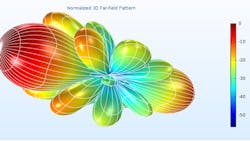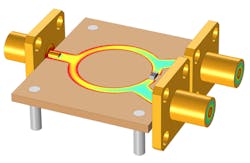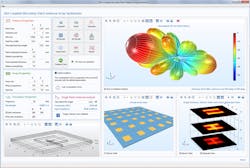Modeling and Simulation Software Adapts to Today’s Needs
This file type includes high resolution graphics and schematics when applicable.
RF/microwave engineers today can choose from among a range of currently available simulation tools to meet their specific design needs. One company that specializes in modeling and simulation is COMSOL. The company’s software platform, COMSOL Multiphysics, is a tool designed for physics-based modeling and simulation. On top of that, COMSOL Multiphysics can be expanded with a large number of add-on products that target specific areas, such as electrical, mechanical, acoustic, fluid, thermal, and chemical applications.
One add-on of particular note is the RF Module. This software allows for modeling and simulation of various RF/microwave components, including filters, power dividers, and couplers. Antenna design is another main areas targeted by the software. Other applications supported by the RF Module include microwave heating and metamaterials.
Overview
I recently had the opportunity to spend some time with the RF Module and get a better sense of its capabilities. Those who have no prior experience with COMSOL Multiphysics ought to know that the RF Module is based on the finite-element method (FEM), which is used to solve Maxwell’s equations.
Once a model is simulated, users can observe predefined plots of electric and magnetic fields. Users can also view S-parameter plots, as well as other results from a particular simulation. In addition, the capabilities of the RF Module extend beyond traditional electromagnetic (EM) modeling—the created models can include effects like temperature rise and structural deformations.
Application Gallery
The Application Gallery is COMSOL’s own library of demo models. Most of these demos include the actual model file, as well as a step-by-step guide that explains how to build the model from scratch. The library contains a variety of microstrip designs, such as a connectorized Wilkinson power divider (Fig. 1), a branchline coupler, and a rat-race coupler.
Moreover, various filter designs are provided, including a lumped-element lowpass filter, a coupled-line bandpass filter, and several waveguide filters. COMSOL also supplies a large number of antenna models, among them dipole, microstrip patch, and Vivaldi antennas. Many other demo models can be found on COMSOL’s website—more than 80 specific to the RF Module are currently available.
The step-by-step instructions can be highly beneficial to someone new to COMSOL. By following these guides, one can learn how to create geometries, add materials, specify input/output (I/O) ports, and more. For example, users can become familiar with the various transform options, such as Array, Copy, Mirror, and Rotate. These functions are intended to streamline the task of creating geometries.
Of course, the ultimate goal of creating a model is to obtain simulation results. The guides demonstrate how to configure different kinds of I/O ports, like coaxial and waveguide types. Readers are further instructed on how to define a mesh, perform a simulation, and ultimately view the simulation results (e.g., electric field distribution and S-parameter plots).
One major benefit of the Application Gallery is that it enables users to create their own designs using an existing demo model as a baseline. In essence, users can identify a demo model similar to their intended design. That model can then be modified in whatever manner necessary to create the desired model. Alternatively, one could follow the step-by-step guide, with the exception of using the actual project parameters in place of those presented in the documentation. In any case, the Application Gallery becomes a major advantage for users.
Application Builder
The Application Builder is another significant feature of COMSOL Multiphysics. It essentially makes it possible to create models that can then be used as customized applications. This capability allows a simulation specialist to build a model that can be customized by other designers without the time and effort needed to return to the original design process. One example is the Slot-Coupled Microstrip Patch Antenna Array Synthesizer found in the Application Gallery (Fig. 2).
User Presentations
The COMSOL Conference 2016 featured a number of user presentations pertinent to RF/microwave engineering. They included “Electromagnetic Modeling of a Millimeter-Wavelength Resonant Cavity,” “Modeling Post Convection Cooling of High Power Waveguide,” “Multiphysics Analysis of RF Cavities for Particle Accelerators: Perspective and Overview,” and many others. Anyone who is interested in learning about the research areas enabled by COMSOL should take a look at these presentations.
Final Thoughts
The RF Module can benefit anyone involved with designing antennas, filters, waveguide components, and more. For one, the Application Gallery is a good resource for both experienced and new users. New users can become acquainted with the software by taking advantage of the various demo models. The step-by-step guides are a practical approach to explain the process of building a model. Moreover, the Application Builder is primed for emerging needs like 5G wireless networks. Those who have yet to use COMSOL Multiphysics should give it a try.
This file type includes high resolution graphics and schematics when applicable.




